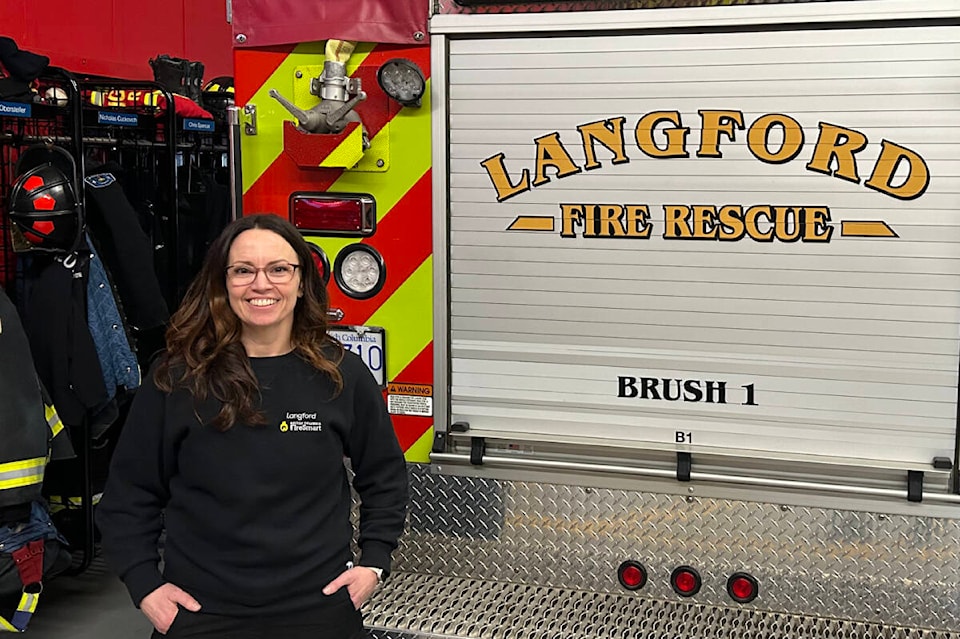Even in coastal areas that are generally more resilient to wildfires, preparations for the upcoming wildfire season are underway.
Take Langford, for example. It isn’t a community that’s traditionally threatened by seasonal wildfires as much as those in B.C.’s interior, but it still has problem areas near parks and forests, and it still has homes that are vulnerable to fire.
Climate change is making these problems worse, says Tianna Dupuis, Langford Fire Rescue’s FireSmart coordinator.
“Our summers are getting drier,” she said. “It’s sucking the moisture out of our forests.”
The snowpack is below average across B.C., and down to 30 per cent of normal on Vancouver Island, according to the latest estimates from B.C.’s River Forecast Centre. The potential for early seasonal drought conditions is increasing daily.
“Drought and wildfire tend to go hand in hand,” said the centre’s hydrologist, Jonathan Boyd. “The snow numbers we have, they’re far more concerning than last year, across the board throughout the whole province.”
This is fraying nerves. Federal Emergency Preparedness Minister Harjit Sajjan recently said the country could have an even worse fire season than last, which was Canada’s worst on record.
The BC Wildfire Service gave a slightly more positive outlook for Vancouver Island, telling Black Press Media in a statement that the Island was one of the places in the province that did return to a normal seasonal drought level before the winter.
But the statement also notes that a dry winter and low snowpack can lead to increased risk, adding that at this point, seasonal rains in June will be the determining factor for the severity of the upcoming fire season.
It is also a bit different for the southern parts of Vancouver Island compared to the North, says Boyd. Because the south already gets less snow, snowpack is not a very good indicator of what a fire season will be like, it’s more dependent on rain and temperatures. With heat like the area has experienced in recent summers, the fire risk soars.
“Temperatures of 35 or 40 degrees — when the trigger does happen, it can be quite explosive in terms of how rapid the fires can develop,” he said.
Mindful of the unknowns, the provincial government and local firefighters are already planning and preparing for what could be an early start to another gruelling fire season.
The work starts at home
Dupuis emphasizes the need to change the coastal mindset towards fire.
Her job is to try to educate people to buy in to the notion that their homes could be someday impacted by fire and convince them to make small-scale changes to their properties.
People may not realize it’s not the flames approaching a house they need to worry about, it’s the flaming embers being blown around, she said.
“That ember storm is going to come first, it’s not going to be like a big wall of flame,” Dupuis said. “It’s like a snowstorm.”
Those embers build up next to buildings as they hit walls and drop to the ground. This causes anything leaning up against building — like woodpiles or cedar hedges — to go up in flames and in turn light the home on fire.
The embers can also cause smaller, more insidious fires in areas with material like bark mulch covering the ground.
“They’re slow and they’re low and they just smoulder under the ground,” Dupuis said.
Instead of lining the areas around a home with a combustible woody material, Dupuis said something like lava rock can be a more fireproof option.
To help homeowners clean up and make their homes more fire resistant, Dupuis will be holding several community engagement sessions with schools and at local parks, as well as hauling out a wood chipper to some high risk communities to make it easier for people to clean up their properties.
Part of a larger effort
In addition to her role as a FireSmart coordinator, Dupuis has worked in Saanich as a 911 dispatcher — a job in which she received hundreds of calls for bark mulch fires — and as a volunteer helping wildfire evacuees with Emergency Support Services (ESS).
These multiple roles reflect the broader provincial effort to involve multiple levels of government, various ministries and and First Nations in emergency preparedness. After learning from several recent catastrophic fire seasons, the provincial government is trying to do better at this sort of coordination and planning.
Some coordination has long taken place between BC Wildfire and local fire departments, but joint efforts are now reaching new levels.
“Now they’re coming together and being like, ‘Hey, we need to work together, we need to cross train our employees,’” Dupuis said.
The shift also includes less of an emphasis solely on disaster response. Like Dupuis’ FireSmart efforts in Langford, the provincial government is seeking to fit mitigation, preparedness and recovery into a new, broader emergency management framework.
That reflects the broader impact wildfires have begun to have on places where they were once an afterthought.
When Dupuis was helping wildfire evacuees, she was on he Island, but was assisting people evacuated from West Kelowna.
She noted a community not impacted by fire can be by smoke; and if people’s homes aren’t being threatened, perhaps they know someone in the interior of B.C. whose home is.
And the long hot summers may eventually bring fire closer to people’s doorsteps than they thought possible.
“Climate change — call it what you want — it is going to happen eventually,” she said. “And you might as well just start having the conversations early.”
